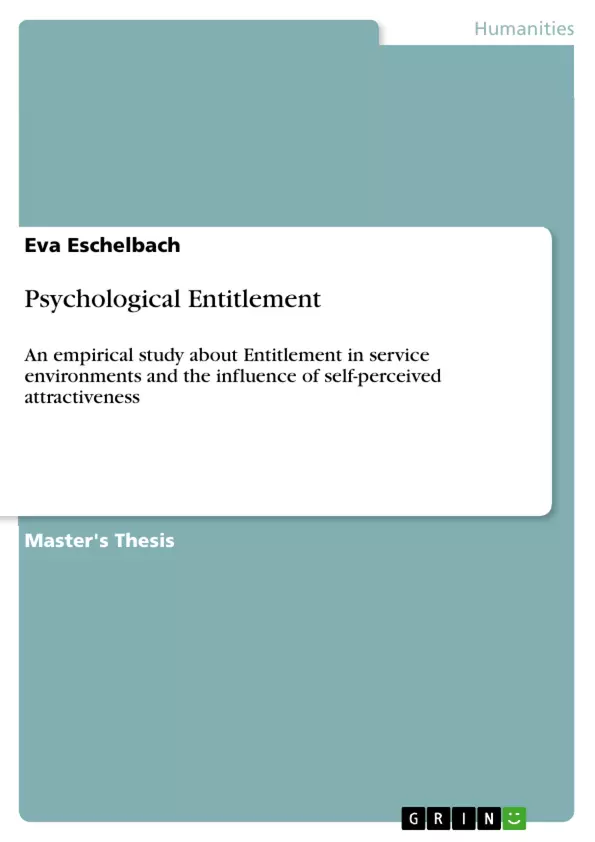
Psychological Entitlement
Masterarbeit, 2019
52 Seiten, Note: 70%
Leseprobe
Inhaltsverzeichnis (Table of Contents)
- 1 Introduction
- 2 Literature Review
- 2.1 Entitlement
- 2.1.1 Definitions of Entitlement
- 2.1.2 Entitlement and Narcissism
- 2.1.3 Forms of Entitlement and its effects
- 2.2 Physical Attractiveness
- 2.2.1 General Definition of physical attractiveness
- 2.2.2 Self-perception of physical attractiveness
- 2.3 Consumer Expectations in Service Environments
- 2.1 Entitlement
- 3 Methodology
- 3.1 Design
- 3.2 Ethical Considerations
- 3.3 Participants
- 3.4 Instruments
- 3.4.1 Entitlement
- 3.4.2 Physical Attractiveness
- 3.4.3 Service Expectations
- 3.4.4 Demographic Questions
- 3.5 Procedure
- 4 Results
- 5 Discussion
- 5.1 Marketing Implication
- 5.2 Limitations
- 5.3 Future Research
- 6 Conclusion
Zielsetzung und Themenschwerpunkte (Objectives and Key Themes)
This study empirically investigates psychological entitlement within service environments and its correlation with self-perceived attractiveness. The research aims to understand the interplay between these factors and their impact on consumer behavior and service interactions.
- The definition and measurement of psychological entitlement.
- The relationship between entitlement and self-perceived attractiveness.
- The impact of entitlement on consumer expectations in service settings.
- The methodological considerations in studying entitlement and attractiveness.
- Potential marketing implications based on the findings.
Zusammenfassung der Kapitel (Chapter Summaries)
1 Introduction: This chapter likely introduces the research topic of psychological entitlement, its relevance in service environments, and the study's overall objectives. It sets the stage for the literature review and methodology by outlining the problem statement and research questions. The introduction will contextualize the study within the broader field of consumer behavior and service management, highlighting the gap in existing research that the study addresses. It will likely conclude with a brief overview of the structure of the thesis.
2 Literature Review: This chapter provides a comprehensive overview of existing literature on psychological entitlement, physical attractiveness, and consumer expectations in service environments. It synthesizes previous research findings to establish a theoretical framework for the study, defining key concepts and exploring the relationships between them. This chapter will likely delve into different facets of entitlement, exploring its various definitions, its relationship with narcissism, and its consequences. Similarly, the discussion of physical attractiveness will likely encompass both objective measures and subjective self-perceptions, clarifying how these relate to consumer behavior. The review will conclude by presenting a synthesis of the literature and posing the study's hypotheses.
3 Methodology: This chapter details the research design, ethical considerations, participant selection, and data collection instruments used in the study. It explains the rationale behind the chosen methods and provides a clear and comprehensive description of the procedures followed to ensure the study's rigor and validity. A detailed explanation of the measures used to assess entitlement, physical attractiveness, and service expectations will be given. This section will also cover the demographic questions included in the study and the data analysis techniques employed to test the hypotheses.
4 Results: This chapter presents the quantitative findings of the study. It will describe the statistical analyses performed and the results obtained, using tables and figures to present the data clearly and concisely. The results section will be focused on providing a detailed and systematic account of the statistical outcomes of the study. It will present evidence related to the hypothesized relationships between entitlement, self-perceived attractiveness, and service expectations, laying the groundwork for the discussion of the findings.
5 Discussion: This chapter interprets the findings presented in the results section and discusses their implications. It relates the research outcomes to the existing literature, highlighting the study's contributions and limitations. The discussion section likely focuses on the implications of the findings for marketing and service management, providing potential applications and recommendations for practitioners. This section may also suggest avenues for future research based on the findings and limitations of the current study.
Schlüsselwörter (Keywords)
Psychological entitlement, self-perceived attractiveness, service expectations, consumer behavior, service environments, narcissism, empirical study, marketing implications.
Frequently Asked Questions: Comprehensive Language Preview
What is the topic of this research study?
This research study empirically investigates psychological entitlement within service environments and its correlation with self-perceived attractiveness. It aims to understand how these factors interplay and impact consumer behavior and service interactions.
What are the key themes explored in the study?
The study explores the definition and measurement of psychological entitlement, the relationship between entitlement and self-perceived attractiveness, the impact of entitlement on consumer expectations in service settings, the methodological considerations in studying entitlement and attractiveness, and potential marketing implications based on the findings.
What does the literature review cover?
The literature review provides a comprehensive overview of existing research on psychological entitlement, physical attractiveness, and consumer expectations in service environments. It synthesizes previous findings to establish a theoretical framework, defining key concepts and exploring their relationships. It delves into different facets of entitlement (definitions, relationship with narcissism, consequences), and explores both objective and subjective aspects of physical attractiveness and their relation to consumer behavior. Finally, it presents a synthesis and poses study hypotheses.
What is the methodology employed in the study?
The methodology chapter details the research design, ethical considerations, participant selection, and data collection instruments. It explains the rationale for the chosen methods and provides a comprehensive description of procedures to ensure rigor and validity. It includes a detailed explanation of measures used to assess entitlement, physical attractiveness, service expectations, and demographic questions, as well as the data analysis techniques.
How are the results presented?
The results chapter presents the quantitative findings of the study, describing the statistical analyses performed and the results obtained using tables and figures. It provides a detailed and systematic account of the statistical outcomes, presenting evidence related to the hypothesized relationships between entitlement, self-perceived attractiveness, and service expectations.
What is discussed in the discussion chapter?
The discussion chapter interprets the findings, relating them to existing literature and highlighting the study's contributions and limitations. It focuses on the implications for marketing and service management, providing potential applications and recommendations. It also suggests avenues for future research.
What are the key keywords associated with this research?
Key keywords include: Psychological entitlement, self-perceived attractiveness, service expectations, consumer behavior, service environments, narcissism, empirical study, marketing implications.
What is included in the table of contents?
The table of contents includes: an introduction, a literature review (covering entitlement, physical attractiveness, and consumer expectations), a methodology section (design, ethical considerations, participants, instruments, and procedure), a results section, a discussion section (marketing implications, limitations, and future research), and a conclusion.
What is the overall aim of the study?
The overall aim is to empirically investigate the relationship between psychological entitlement, self-perceived attractiveness, and consumer behavior within service environments, providing insights with potential marketing implications.
Details
- Titel
- Psychological Entitlement
- Untertitel
- An empirical study about Entitlement in service environments and the influence of self-perceived attractiveness
- Hochschule
- University of Sussex
- Note
- 70%
- Autor
- Eva Eschelbach (Autor:in)
- Erscheinungsjahr
- 2019
- Seiten
- 52
- Katalognummer
- V514261
- ISBN (eBook)
- 9783346127792
- ISBN (Buch)
- 9783346127808
- Sprache
- Englisch
- Schlagworte
- Consumer Psychology Konsumpsychologie Attractiveness Entitlement Services Customer Experiences
- Produktsicherheit
- GRIN Publishing GmbH
- Preis (Ebook)
- US$ 19,99
- Preis (Book)
- US$ 28,99
- Arbeit zitieren
- Eva Eschelbach (Autor:in), 2019, Psychological Entitlement, München, Page::Imprint:: GRINVerlagOHG, https://www.diplomarbeiten24.de/document/514261
- Autor werden
- Ihre Optionen
- Vertriebskanäle
- Premium Services
- Autorenprofil
- Textarten und Formate
- Services für Verlage, Hochschulen, Unternehmen

- © GRIN Publishing GmbH.
- Alle Inhalte urheberrechtlich geschützt. Kopieren und verbreiten untersagt.
- info@grin.com
- AGB
- Open Publishing
Der GRIN Verlag hat sich seit 1998 auf die Veröffentlichung akademischer eBooks und Bücher spezialisiert. Der GRIN Verlag steht damit als erstes Unternehmen für User Generated Quality Content. Die Verlagsseiten GRIN.com, Hausarbeiten.de und Diplomarbeiten24 bieten für Hochschullehrer, Absolventen und Studenten die ideale Plattform, wissenschaftliche Texte wie Hausarbeiten, Referate, Bachelorarbeiten, Masterarbeiten, Diplomarbeiten, Dissertationen und wissenschaftliche Aufsätze einem breiten Publikum zu präsentieren.
Kostenfreie Veröffentlichung: Hausarbeit, Bachelorarbeit, Diplomarbeit, Dissertation, Masterarbeit, Interpretation oder Referat jetzt veröffentlichen!
- GRIN Verlag GmbH
-
- Nymphenburger Str. 86
- 80636
- Munich, Deutschland
- +49 89-550559-0
- +49 89-550559-10
- info@grin.com
-









